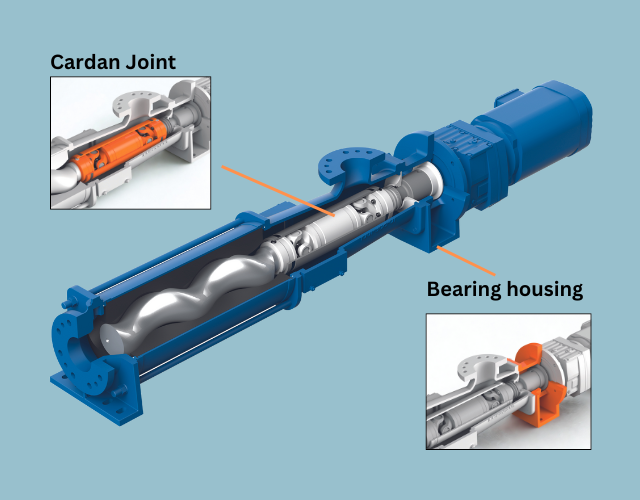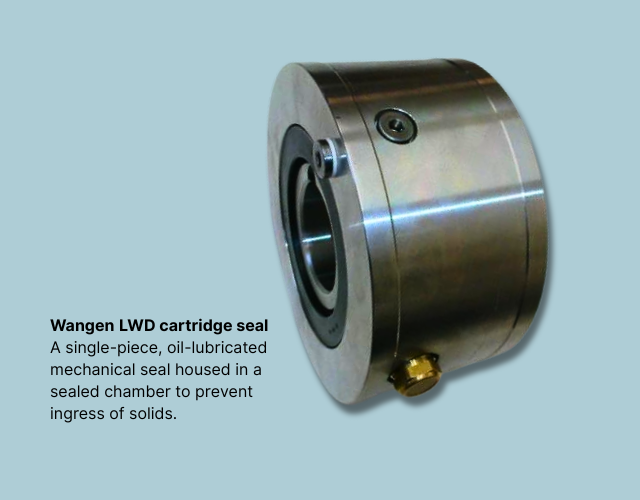Pump Types
Auto Prime
Air-operated
Concrete Washdown
Dredge Pumps - Dewatering
Dredge Pumps - Sludge & Slurry
Dredges
Flexi, Trash & Diaphragm
High Head Pumps
Handy-sized Pumps
Lamella Settling Tanks
Peristaltic
pH Correction
Piston Pumps
PTO (auto prime)
Centrifugal
Primary Sludge
Progressive Cavity
Shore-mounted
Stirrers
Submersibles
Proportional Dosing
Settling Tanks & Bag
Submersibles - Drainage
Submersibles - Slurry & Sludge
Stirrers - WWTP
Trash, Flexi & Diaphragm
Water Quality Monitoring
Wellpointing
Chemicals
Food Processing
Fuels & Oils
Hot Oil
Hot Water
Hygienic
Marine
Solids Handling Pumps
Vacuum & Blowing
Viscous Fluids Pumps
Wastewater

Comprehensive water treatment and monitoring solutions
Wangen Progressive Cavity Pumps
Engineering Brilliance
For New Zealand industries where abrasion, fibrous content, and maintenance costs are key concerns, Wangen Progressive Cavity (PC) pumps offer a economically and technically superior solution.
Their robust mechanical design with bearing isolation, durable cardan joints, and hardened rotors contribute to exceptional wear life. Wangen PC pumps also run at lower RPMs, resulting in less heat, vibration, and ultimately, wear. The quick-change cartridge seals further reduce downtime during maintenance, enhancing overall efficiency.
Blockage-free operation
Wangen’s fully encapsulated cardan joint has needle roller bearings and a protective sleeve. It is engineered for continuous, blockage-free operation in abrasive and fibrous media - minimising wear and eliminating common failure points associated with conventional pin joints. Wangen has also integrated a separate bearing housing between the pump and gearbox to isolate axial and radial loads from the drive, again, significantly reducing wear and extending service life.
- Fully sleeved universal joint with needle roller bearings designed for long-term durability
- High power transmission designed to maintain efficiency at high pressures.
- The joint easily handles radial and thrust loading.

Maintenance-free Mechanical Seal
Wangen's LWD Cartridge mechanical seal offers a compact, pre-assembled design that enables fast, tool-free replacement. Pump reliability is improved and downtime reduced due to minimal leakage and wear. The net result is a highly efficient and user-friendly sealing solution, ideal for demanding applications .
- Pre-assembled, oil-lubricated mechanical seal in a sealed chamber.
- Prevents ingress of solids and simplifies replacement.
- Simple replacement (a single piece).
- Ideal for abrasive applications.

Overview of our Wangen Progressive Cavity Pumps
Wangen produces an extensive range of hopper feed pumps for slurries and pastes with high solids content (KL-R Series) and dewatered sludge (KL-RU, KL-RQ, KL-RS and KL-R Triplex models).
- Max flow: 160m3/hr
- Max pressure: 48 bar
- Max solids: 45%
- For extremely dry or lumpy material
Very low maintenance and highly dependable, Wangen KL Series of effluent PC pumps perform at very low rpm and features a unique, encapsulated cardon joint that is wear and maintenance-free.
- Power: 7.5 – 18.5kW
- Speed: 152 – 260 rpm
- Max flow: 60m³/hr
- Max pressure: 12 bar
Wangen's KL-S, KB-S and KB22S self-priming PC pumps convey high viscous media up to 200,000mPA-s with or without solids. The KB22S is designed specifically for dosing.
- Max Flow: 560 m3/hr
- Max Pressure: 48 bar
- Materials: S/steel, cast iron
Wangen’s KB-SL, KL-SL and KL-RF hygienic progressive cavity pumps are tailored to convey low to very high viscosity media.
- Max flow: 150m3/hr
- Max temp.: 140°C
- Max pressure: 48 bar
- Max viscosity: 200,000 mPa-s
Available as a mobile or stationery unit, the MX-series hygienic progressive cavity pump offers differential pressure up to 80 bar.
- Max flow: 100m3/hr
- Max pressure: 80 bar
- CIP/SIP cleaning possible
Wangen KL-T Series Progressive Cavity Immersion pumps safely convey media from tanks and pools with high metering accuracy even at low rpm.
- Max Flow: 102m3/hr
- Max Pressure: 6 bar
- Max viscosity: 200,000 mPA-s
- Max Dry Solids: 16%
KL-RL series progressive cavity pumps ensure nearly pulsation-free flow with a large hopper and screw conveyors to optimise pumping of non flowable product.
- Max flow: 65m3/hr
- Max pressure: 48
- Max solids: 95mm
The KL-RF hopper feed series is available in S-, L-, and H- rotor/stator geometries and is well-suited to plasticising blocks of fat or butter.
- Max flow: 22m3/hr
- Max pressure: 48
- Max solids: 95mm
Designed for agricultural use, Wangen’s PTO shaft pumps vacuum-load, unload and distribute tank manure supplies, or convey liquid feed.
- High suction power
- Insensitive to foreign bodies
- Max flow: 470m3/hr
- Max pressure: 16 Bar
Download the Wangen Brochure
In the field
Here are some examples of our solutions being used.
Read Sludge & Slurry Articles
Make an enquiry
FAQ
At Prime Fluid Management, we understand that every fluid management challenge brings unique considerations. Here, you’ll find clear, practical answers and expert guidance to help you maximise uptime, achieve regulatory compliance, extend equipment life, and implement the most effective solution for your site.
A slurry pump is designed to move mixtures of liquid and solid particles where the liquid component helps the material flow. It is built with abrasion and corrosion resistant materials and a robust design to handle the wear from suspended solids.
A sludge pump is designed to handle much thicker and stickier material known as sludge which has a higher solid content. These pumps often use positive displacement or slow moving mechanisms to avoid clogging and manage dense viscous fluids.



